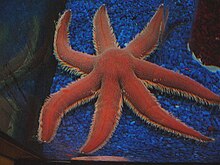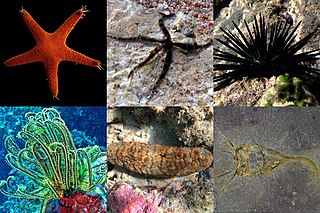
An echinoderm is any deuterostomal animal of the phylum Echinodermata, which includes starfish, brittle stars, sea urchins, sand dollars and sea cucumbers, as well as the sessile sea lilies or "stone lilies". While bilaterally symmetrical as larvae, as adults echinoderms are recognisable by their usually five-pointed radial symmetry, and are found on the sea bed at every ocean depth from the intertidal zone to the abyssal zone. The phylum contains about 7,600 living species, making it the second-largest group of deuterostomes after the chordates, as well as the largest marine-only phylum. The first definitive echinoderms appeared near the start of the Cambrian.

Starfish or sea stars are star-shaped echinoderms belonging to the class Asteroidea. Common usage frequently finds these names being also applied to ophiuroids, which are correctly referred to as brittle stars or basket stars. Starfish are also known as asteroids due to being in the class Asteroidea. About 1,900 species of starfish live on the seabed in all the world's oceans, from warm, tropical zones to frigid, polar regions. They are found from the intertidal zone down to abyssal depths, at 6,000 m (20,000 ft) below the surface.

Brittle stars, serpent stars, or ophiuroids are echinoderms in the class Ophiuroidea, closely related to starfish. They crawl across the sea floor using their flexible arms for locomotion. The ophiuroids generally have five long, slender, whip-like arms which may reach up to 60 cm (24 in) in length on the largest specimens.

The common starfish, common sea star or sugar starfish is the most common and familiar starfish in the north-east Atlantic. Belonging to the family Asteriidae, it has five arms and usually grows to between 10–30 cm across, although larger specimens are known. The common starfish is usually orange or brownish in color, and sometimes violet; specimens found in deeper waters are pale. The common starfish is found on rocky and gravelly substrates where it feeds on mollusks and other benthic invertebrates.
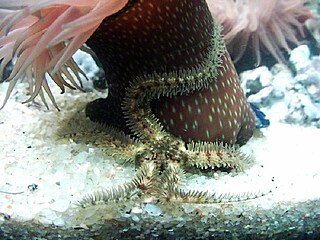
Ophiothrix fragilis is a species of brittle star in the order Ophiurida. It is found around the coasts of western Europe and is known in Britain as the common brittle star. It is also found along the coast of South Africa where it is known as the hairy brittle star.

Ophiura ophiura or the serpent star is a species of brittle star in the order Ophiurida. It is typically found on coastal seabeds around northwestern Europe.

Sphaerechinus granularis is a species of sea urchin in the family Toxopneustidae, commonly known as the violet sea urchin, or sometimes the purple sea urchin. Its range includes the Mediterranean Sea and eastern Atlantic Ocean.
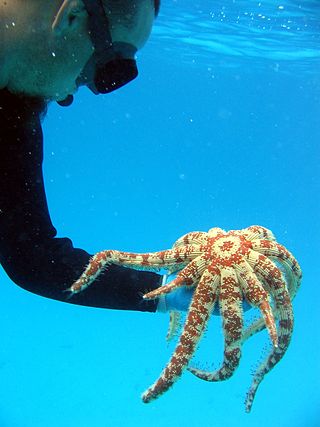
Luidia is a genus of starfish in the family Luidiidae in which it is the only genus. Species of the family have a cosmopolitan distribution.

Ophiocomina nigra, commonly known as the black brittle star or black serpent star, is a species of marine invertebrate in the order Ophiurida. It occurs in the north-eastern Atlantic Ocean, the North Sea, and the Mediterranean Sea.
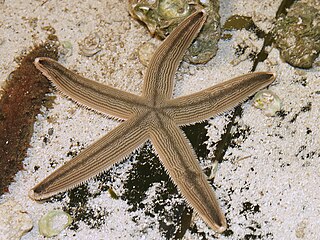
Luidia clathrata is a tropical species of starfish in the family Luidiidae. It is variously known as the slender-armed starfish, the gray sea star, or the lined sea star. It is found in the western Atlantic Ocean.

Luidia magnifica, the magnificent star, is a species of starfish in the family Luidiidae. It is found in the Pacific Ocean.
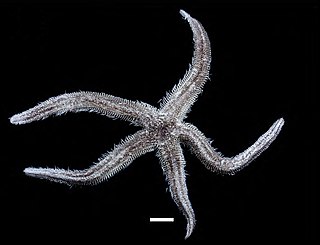
Luidia superba is a tropical species of starfish in the family Luidiidae. A single specimen was found off the Pacific coast of Colombia in 1888; the species has since been found in the Galapagos Islands. It is endemic to this area and has not been recorded elsewhere.

Luidia senegalensis, the nine-armed sea star, is a tropical species of starfish in the family Luidiidae found in the western Atlantic Ocean.

Luidia foliolata, the sand star, is a species of starfish in the family Luidiidae found in the northeastern Pacific Ocean on sandy and muddy seabeds at depths to about 600 m (2,000 ft).

Ophiura albida is a species of brittle star in the order Ophiurida. It is typically found on the seabed in the north eastern Atlantic Ocean and in the Mediterranean Sea and is sometimes known as the serpent's table brittle star.

The spiny sand seastar is a species of starfish in the family Luidiidae. It is found in shallow parts of the China Sea and in the vicinity of the Korean archipelago. The tissues of this starfish have been found to contain several secondary metabolites with medicinal potential.
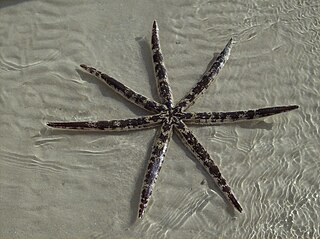
Luidia maculata is a species of starfish in the family Luidiidae in the order Paxillosida. It is native to the Indo-Pacific region. It is commonly known as the eight-armed sea star because, although the number of arms varies from five to nine, eight arms seems to be the most common.

Ophiopholis aculeata, the crevice brittle star or daisy brittle star, is a species of brittle star in the family Ophiactidae. It has a circum-polar distribution and is found in the Arctic Ocean, the northern Atlantic Ocean and the northern Pacific.

Luidia savignyi is a species of starfish belonging to the family Luidiidae. The species is found in the tropical and subtropical Indo-Pacific region. It is a large starfish and preys on other echinoderms.
